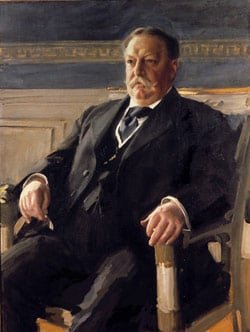William H. Taft became the 27th US President in 1909 on the Republican Party ticket and continued in that office till 1913. Prior to being the US President, William Howard Taft occupied a number of administrative posts. During his Presidency, US witnessed a significant expansion of the civil service. The subject of Law had always been preferred by Taft ahead of politics.
William H. Taft was born in 1857 in Ohio of his mother Louisa Torrey and father Alphonso Taft. He was admitted in Woodward High School in 1874. Being a good debater, he was registered as the member of the literary and debate society, Linonian Society. For further education, he was enrolled in Yale College. In his graduation examination, he secured the second position. Later in 1880, he earned the graduation with Bachelor of Laws from Cincinnati Law School.
After graduating from Cincinnati Law School, William H. Taft got admission in the Ohio bar. there he was appointed as Assistant Prosecutor of Hamilton County, Ohio. From 1887 to 1900, Taft was appointed for the following posts –
- Judge of the Ohio Superior Court (1887)
- Solicitor General of the United States(1890)
- Judge of United States Court of Appeals for the Sixth Circuit(1892)
- Dean and professor of constitutional law at the University of Cincinnati(1896-1900)
Taft was introduced to theodore Roosevelt in the course of his job in the United States Court of Appeals for the Sixth Circuit. In 1900, Taft was appointed by the incumbent US President William McKinley as the chairman of a commission to set up a civilian government in Philippines. Later from 1901 to 1903, he remained the civilian Governor-General of the Philippines. In 1904 during the Presidency of Roosevelt, he was appointed as the Secretary of War. As a Secretary, Taft played a significant role in putting an end to the revolt in Cuba. For a brief period in 1906, he worked as the Civil Governor of Cuba. He also did a commendable job by taking initiatives as a supervisor in the construction of the Panama Canal.
Facts |
|
|---|---|
| Full Name: | William Howard Taft |
| Date of Birth: | September 15, 1857, Cincinnati, Ohio |
| Died on: | March 8, 1930, Washington, D.C. |
| Burial site: | Arlington National Cemetery, Arlington, Virginia |
| Parents: | Alphonso and Louisa Torrey Taft |
| Spouse: | Helen Herron (1861-1943; m. 1886) |
| Children: | Robert Alphonso (1889-1953); Helen Herron (1891-1987); Charles Phelps (1897-1983) |
| Religion: | Unitarian |
| Education: | Yale University (B.A., 1878); Cincinnati Law School (L.L.B., 1880) |
| Profession(s): | Lawyer, law professor |
| Government ranks: | Judge; U.S. Solicitor general; Philippines governor, secretary of war under Theodore Roosevelt; U.S. Supreme Court chief justice |
| Political party: | Republican |
| President Term: | March 4, 1909-March 4, 1913 |
| Age when assumed office: | 51 |
Presidential Term and its details |
|
|---|---|
| Dates: | March 4, 1909-March 4, 1913 |
| Vice President: | James S. Sherman (1909-12) |
| None (1912-13) | |
Outcome of the Elections |
|||
|---|---|---|---|
| 1908 | Presidential / Vice Presidential Candidates | Popular votes | Electoral votes |
| William Howard Taft / James S. Sherman (Republican) | 7678908 | 321 | |
| William Jennings Bryan / John W. Kern (Democratic) | 6409104 | 162 | |
Snapshot of William H. Taft’s life |
|
|---|---|
| 1857 | Born in Ohio |
| 1880 | Admitted to Ohio bar and works as court reporter for the Cincinnati Commercial newspaper |
| 1883 | Works as a lawyer in private practice |
| 1887-90 | Serves in Ohio Superior Court |
| 1890-92 | Serves as U.S. Solicitor general |
| 1892-1900 | Serves as judge in the U.S. Circuit Court |
| 1901-4 | Serves as civil governor of the Philippines |
| 1904-8 | Serves as secretary of war |
| 1909-13 | Serves as twenty-seventh U.S. President |
| 1912 | Loses presidential reelection bid to Woodrow Wilson |
| 1921-30 | Serves as chief justice of the U.S. Supreme Court |
| 1930 | Dies in Washington, D.C. |
In the US Presidential Election 1908, William H. Taft made a convincing win over William Jennings Bryan. the civil service of US was expanded considerably during the Presidency of William H. Taft. the Interstate Commerce Commission was strengthened in his times through the establishment of parcel post system and postal savings bank.
He issued 80 lawsuits to establish his pursuance for trusts. the federal income tax system was introduced in his time following the enactment of the 16th Amendment. the 17th Amendment was also supported by Taft, which helped in the process of election of senators by the US citizens. the foreign relations of US were also strengthened during his time. He started different missions with the objective to establish peace in the world. the arbitration treaties were signed by US with Britain and France with an aim to restore peace. Many underdeveloped nations of Asia and Latin America were provided the economic development by William H. Taft.
During his Presidency, William H. Taft distanced himself from the conservatives within the Republican Party. He preferred himself to be called ‘progressive’, who held a belief in the power of the law to eradicate the problems of the society. His relationship with Roosevelt turned bitter because of his intimacy with the Progressives. During the 1912 US Presidential Election, taft was nominated by the Republicans over Roosevelt. But the Democratic candidate Woodrow Wilson recorded a victory over him in the Presidential Election to become the 28th US President.
In his post-Presidential days, William H. Taft was appointed as the Professor of Law at Yale Law School. In 1921, Taft took over the honorable post of Chief Justice of US. His life came to an end in 1930, primarily due to illness.

